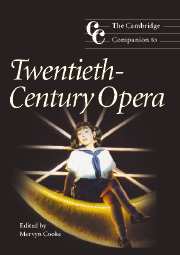Book contents
- Frontmatter
- Part one Legacies
- Part two Trends
- Part three Topographies
- 8 France and the Mediterranean
- 9 Austria and Germany, 1918–1960
- 10 Eastern Europe
- 11 Russian opera: between modernism and romanticism
- 12 American opera: innovation and tradition
- 13 Opera in England: taking the plunge
- Part four Directions
- General index
- Index of operas
8 - France and the Mediterranean
from Part three - Topographies
Published online by Cambridge University Press: 28 September 2011
- Frontmatter
- Part one Legacies
- Part two Trends
- Part three Topographies
- 8 France and the Mediterranean
- 9 Austria and Germany, 1918–1960
- 10 Eastern Europe
- 11 Russian opera: between modernism and romanticism
- 12 American opera: innovation and tradition
- 13 Opera in England: taking the plunge
- Part four Directions
- General index
- Index of operas
Summary
With Debussy's Pelléas et Mélisande and Dukas's Ariane et Barbe-bleue, French opera moved decisively beyond broadly imitative ‘wagnérisme’ to a more individual expressive language, and a far stronger sense of synthesizing Wagner's achievements rather than producing rather pale copies. But despite the innovations of Debussy and Dukas, the shadow of Wagner was to hang over a good deal of French opera for the first few decades of the twentieth century.
Gabriel Fauré– like Dukas – was among the many French pilgrims to Bayreuth in his youth, but his only completed opera came towards the end of his career. Already a successful composer of incidental music for plays – notably for Edmond Haraucourt's Shakespeare adaptation Shylock (1889) and Maeterlinck's Pelléas et Mélisande (1898) – Faurébegan work in about 1907 on Pénélope, a ‘drame lyrique’ in three acts to a libretto by RenéFauchois. The opera was complete in piano-vocal score by 1912 (when it was published by Heugel; a revised edition appeared in 1913). The orchestration, mostly by Faurébut partly by Fernand Pécoud, was completed early the next year in time for the premieres at Monte Carlo on 4 March 1913 and at the brand-new Théâtre des Champs-Elysées in Paris on 10 May 1913. Pénélope was a work which took Fauréconsiderably longer than any other and its attraction for him seems to have been as an affirmation of conjugal love (something Fauréhimself only experienced intermittently); his son Philippe Fauré-Fremiet described it as ‘a new Bonne Chanson on a mythic scale, sung by characters who are larger than life’ (Fauré-Fremiet 1945, 17).
- Type
- Chapter
- Information
- The Cambridge Companion to Twentieth-Century Opera , pp. 123 - 145Publisher: Cambridge University PressPrint publication year: 2005



